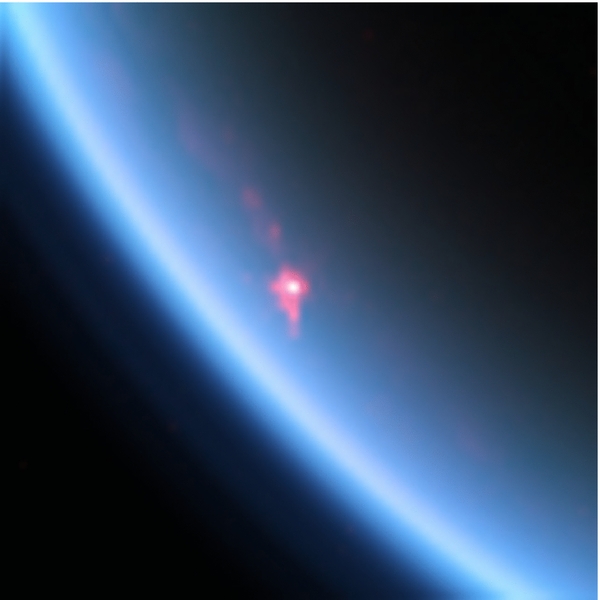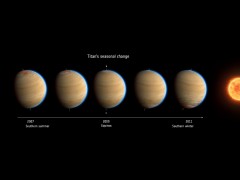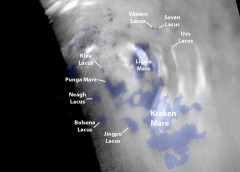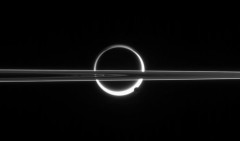
The voice of the sea is seductive;
never-ceasing, whispering, clamoring, murmuring,
inviting the soul to wander for a spell in abysses of solitude;
— Kate Chopin, “The Awakening” (1899)
Replete with metaphor and symbolism, Kate Chopin’s seminal novel presented the sea as a source of empowerment and awakening. Taking a cue from the distinguished American author’s fictional work, NASA’s Cassini spacecraft has possibly observed the evidence of waves on the seas of Titan for the first time, prior to the coming of summer on the moon’s northern hemisphere.
Sharing the title of the most intriguing moon in the whole Solar System with Jupiter’s Europa and Saturn’s Enceladus, Titan, according to planetary scientists and astrobiologists, could be considered an analogue of early Earth before the appearance of life. Enveloped in a thick, opaque nitrogen atmosphere, it is the only known world so far, besides Earth, with seas and lakes on its surface. Although Titan shares a similar geomorphology with Earth, the moon’s chemical composition is vastly different. Its landscapes are covered with hydrocarbons that rain down from the sky, the surface rocks are made of water ice, and the seas and lakes are composed of a mixture of liquid methane and ethane, the elements that make up natural gas on Earth.

As noted in an earlier AmericaSpace article, past observations of Titan’s seas made with NASA’s Cassini spacecraft, which started orbiting Saturn in 2004, have shown them to be dead calm and mirror-like. Since their discovery in 2005, Cassini hadn’t detected even the slightest stir on their surfaces. The most probable causes for the apparent stillness of these alien waters, according to planetary scientists, had been either the change of the seasons or a very high viscosity of the liquids in Titan’s seas that would make them appear similar to the asphalt pits seen on Earth.
Since Titan shares Saturn’s axial tilt of 27 degrees and the same 29.5-year orbit around the Sun, each season lasts for approximately 7.5 Earth years. When Cassini arrived at the Saturnian system, the northern hemisphere, where 97 percent of the seas and lakes lie, was enveloped in winter darkness. Only after 2009, with the approach of the vernal equinox, did Cassini start making its first detailed observations of the moon’s northern latitudes, which received the warmth of the Sun again after almost 15 years of cold darkness. These observations indicate that something interesting might be happening: The waters might be stirring.
During the 45th Lunar and Planetary Science Conference, held this week in The Woodlands, Texas, scientists presented evidence showing that waves might have appeared on the previously flat Titanian seas while the summer approaches. A new study presented at the Conference, led by Jason W. Barnes, an assistant professor at the University of Idaho’s Department of Physics in Moscow, details the results of observations made by the Visible and Infrared Mapping Spectrometer, or VIMS, onboard the Cassini spacecraft, of Punga Mare, the third largest sea on Titan, located adjacent to the moon’s north pole. During three Cassini flybys of Titan, made between July 2012 and September 2013, VIMS imaged Punga Mare on near and mid-infrared wavelengths of 2, 2.8, and 5 μm, spotting specular reflections of sunlight from the sea’s surface. These appeared as four very bright pixels in the VIMS images, indicating the presence of ripples, leading Barnes’ team to calculate that they shouldn’t extend more than 2-3 cm from the sea’s surface. “We developed a model to interpret these four points as wavy seas reflecting the Sun away from the specular point due to their slopes,” writes the team in their study. “Although we cannot rule out mudflats covered in a liquid layer as the source of these slopes, our best-fit value indicates slope waves of [approximately] 6 degrees. If the roughness is indeed due to waves, then the implied winds are [approximately] 0.76 m/s and the waves themselves should be 2 cm in height. If correct this discovery represents the first sea-surface waves known outside of Earth. That they have previously been undetected and are now evident is consistent with [a previous] hypothesis that winds had previously been low due to seasonal cycles but are picking up as northern spring develops.”

A second study presented at the Conference, led by J.D. Hofgartner, a planetary scientist at Cornell University’s Department of Astronomy, in Ithaca, N.Y., details similar observations that were made of Ligeia Mare, the second largest sea on Titan’s northern hemisphere. Ligeia Mare was imaged by Cassini’s Radar in microwave wavelengths during two flybys in May and July 2013 respectively. Although this specific region of the moon had been studied before, the spacecraft’s Radar detected in May 2013 some bright anomalous features that hadn’t been detected before. More interestingly, these features disappeared by the time of the next flyby in July. Images of Ligeia Mare, taken with Cassini’s Radar and VIMS instruments before and after the two flybys, also failed to detect any signs of these enigmatic bright features. Hofgartner’s team analysed the Radar images, trying to see whether the observed features were a result of data artifacts or were fixed, static structures on the surface instead. The model that best fit the observations was that of waves rippling on Ligeia Mare. “These results indicate that the anomalous features are either unique on Titan or transient in nature,” the study concludes. “The next stage of the analysis is to constrain the possible transient hypotheses for the anomalous features. Cassini’s [fly by of Titan] in August 2014 will provide additional constraints on the physical characteristics of these enigmatic features.”
“Titan may be beginning to stir,” commented Ralph D. Lorenz, a planetary scientist working at the Johns Hopkins University Applied Physics Lab in Baltimore, Md. “Oceanography is no longer just an Earth science.”

A proposed mission that was best suited to settle the question of the existence of waves once and for all was the Titan Mare Explorer, or TiME, a low-cost Discovery-class mission proposal to land on the seas of Titan, which was under consideration from NASA during 2012, but eventually wasn’t picked up by the space agency because of budgetary constrains, in favor of the InSight Mars lander mission, scheduled for launch in 2016. The only option now left to explore Titan and the rest of the Saturnian system for the foreseeable future is the intrepid Cassini spacecraft, whose (already extended twice) mission is projected to end in 2017 with a plunge on Saturn’s cloud tops.
With the summer fast approaching in the northern hemisphere, Cassini will be able to make detailed observations of Titan’s northern seas and lakes during the course of multiple flybys, hopefully unlocking more of their intriguing mysteries. “Titan’s northern lakes region is one of the most Earth-like and intriguing in the Solar System,” says Dr. Linda Spilker, Cassini project scientist at NASA’s Jet Propulsion Laboratory, Pasadena, Calif. “We know lakes here change with the seasons, and Cassini’s long mission at Saturn gives us the opportunity to watch the seasons change at Titan, too. Now that the Sun is shining in the north and we have these wonderful views, we can begin to compare the different data sets and tease out what Titan’s lakes are doing near the north pole.”
Although more fascinating discoveries from Cassini are almost certain during its remaining operational years, there are currently no other scheduled missions bound for Saturn on NASA’s manifest. With the U.S. fiscal environment not showing any signs of change, it is almost certain as well that the detailed and awe-inspiring views of Titan and the rest of the Saturnian system, courtesy of the Cassini spacecraft, will also be our last for several decades to come.
Want to keep up-to-date with all things space? Be sure to “Like” AmericaSpace on Facebook and follow us on Twitter: @AmericaSpace




Another EXCELLENT article Leonidas, although I’m still gritting my teeth and pounding my fists on the desk over, “A proposed mission that was best suited to settle the question of waves once and for all was the Titan Mare Explorer, or TiME, wasn’t picked up by the space agency because of budgetary constraints.” Aaaarrgghh!!
I wholeheartidly share your sentiments Karol.
Considering the fact that TiME would have given us our first direct views of an alien sea and all the wonderful science that would go along with that, one has to wonder, what exactly are they thinking over there at Washington DC, while constantly cutting NASA’s planetary exploration budget.
You will not find any waves. Sorry.